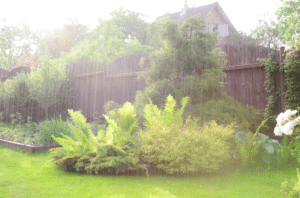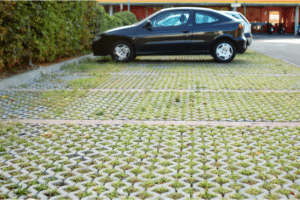

What is green infrastructure? How does it benefit our planet?
To understand what green infrastructure is, we must first understand the basics of stormwater management. Broadly, stormwater management is defined as structural and non-structural methods to control runoff from rainwater and snowmelt from directly entering local waterways or sewer systems to reduce flooding and property damage downstream. These methods also improve water quality by preventing pollution and sediment to reach downstream waterways vital to drinking water and wildlife.
During storm events or snowmelt, an effective stormwater management system will store runoff and release it downstream in a controlled manner. Most existing systems today are considered “gray infrastructure”, which are composed of “unnatural” structures, such as concrete pipes, dams, tanks, or other manufactured conveyance or storage mechanisms.

In gray infrastructure, runoff is typically carried through a network of underground pipes before discharging into a local waterway or body of water. Road runoff, which contains pollutants like heavy metals and suspended solids, often enters the storm pipe network and is carried downstream to the discharge point. These pollutants can negatively affect the environment, wildlife, and drinking water supplies. Within gray infrastructure systems, there is a potential for overflows and flooding when the volume of runoff stormwater collected is too large for its destination.
On the contrary, green infrastructure utilizes methods within our earth’s natural landscape to manage stormwater. These methods absorb and filter stormwater organically, often by integrating vegetation and soil into the system. Green infrastructure solutions are crucial for managing stormwater, improving water quality, and achieving a more sustainable future!
What are some types of green infrastructure solutions?
Within our cities and local communities, heavily engineered gray infrastructure systems have been implemented for ages. The goal of green infrastructure mimic the natural hydrologic conditions to capture, filter, absorb and/or re-use stormwater close to the source. Green infrastructure must be incorporated into our cities and communities to reduce flooding and improve water quality.
Green infrastructure measures, also known as Green Infrastructure Best Management Practices (GI-BMPs), are designed to reduce flooding and improve water quality to treat runoff through vegetation and infiltration into the subsoils and store runoff for reuse. GI BMPs have substantial benefits to communities, especially in urban areas, that include the reduction in the heat island effect, improved air quality through utilization of vegetation, beautification of public spaces, and reduced irrigation needs. GI-BMPs can be implemented in both small-scale and large-scale applications.
Here are a few examples of GI-BMPs:
- Bioretention Systems & Rain Gardens:

Bioretention systems are landscaped areas that collect stormwater, filter out pollutants, and infiltrate stormwater runoff into the ground at the source.A rain garden is an example of a small-scale bioretention BMP. Rain gardens contact native grasses and shrubs and create diverse and attractive landscapes while protecting the natural environment. A bioretention basin can also be utilized as a large-scale BMP to store larger volumes of stormwater runoff.
- Bioswales: A bioswale is a small-scale landscape feature that can convey stormwater runoff while removing pollutants and allowing water to infiltrate. Bioswales consist of native vegetation and can be installed within or along parking areas.
- Planter Boxes: Like rain gard
 ens, planter boxes utilize plants, flowers, and soil to absorb and filter stormwater. They have vertical walls to contain the plants and soil, which also provides temporary water storage until it is absorbed. Planter boxes are commonly found in urban areas with limited space. They’re both effective and visually appealing.
ens, planter boxes utilize plants, flowers, and soil to absorb and filter stormwater. They have vertical walls to contain the plants and soil, which also provides temporary water storage until it is absorbed. Planter boxes are commonly found in urban areas with limited space. They’re both effective and visually appealing. - Infiltration Basins: An infiltration basin captures stormwater and infiltrates it into the ground through highly permeable soil media designed to remove pollutants and promote groundwater recharge. The soils in these systems treat pollutants via settling, filtration, and biochemical activity. A comprehensive soil investigation program is required to properly design an infiltration basin.
 Permeable Pavements: Pavements optimized for the infiltration, treatment, or storage of stormwater in the same location that it falls. These pavements can be designed from concrete, interlocking pavers, porous asphalt, and occasionally other soft materials like wood mulch. Porous pavement systems with a drivable grass surface are also available for fire lanes, access roads, and overflow parking areas with low intensity.
Permeable Pavements: Pavements optimized for the infiltration, treatment, or storage of stormwater in the same location that it falls. These pavements can be designed from concrete, interlocking pavers, porous asphalt, and occasionally other soft materials like wood mulch. Porous pavement systems with a drivable grass surface are also available for fire lanes, access roads, and overflow parking areas with low intensity.- Green Streets: Streets and roadways that are engineered using a combination of several green infrastructure methods like bioswales, planter boxes, and permeable pavements or porous pavements. Incorporating these green systems together controls stormwater runoff, beautifies the community, and reduces rainwater pollution.
Of course, the above examples are just a few ways that green infrastructure is implemented in our world today!
Who is typically involved in green infrastructure projects?
Green infrastructure projects require the collaboration of many entities, often including civil engineers, local government, environmental agencies, home builders, developers, land use departments and beyond! At Carroll Engineering Corporation, our engineers are often involved in designing and managing green infrastructure projects of both small and large scales.
How have green infrastructure laws influenced our local cities and communities?
The United States Environmental Protection Agency (EPA) has implemented several laws and guidelines in effort to better manage stormwater and reduce water pollution on a national scale.
The Clean Water Act (CWA), originally published in 1972, is now known as the Clean Water Act (CWA) Action Plan. This plan was created by the EPA to address water pollution challenges in the US and provides specific numerical guidelines to state environmental programs. These guidelines work to hold states accountable for meeting water pollution regulations. Although the policies vary between states, permits are now required for construction projects, and proposed projects must meet the required EPA regulations to be approved.
For example, in New Jersey, if a developer has plans to build a new community of homes, a stormwater management system must be designed in accordance with local and State regulations. The current Stormwater Rules enacted by the New Jersey Department of Environmental Protection (NJDEP) requires all “major development” to incorporate Green Infrastructure (GI) to meet stormwater runoff quantity, stormwater runoff quality, and ground recharge standards. A developer must submit a stormwater management plan, prepared by a licensed Professional Engineer, for review and approval by the municipality, regional entity, and NJDEP, as applicable.
Additionally, the U.S. Green Building Council (USGBC) created the Leadership in Energy and Environmental Design (LEED) green building certification program. The LEED certification program includes a set of measurable requirements for the design, construction, operation, and maintenance of buildings, communities, and homes. There are some US agencies at the federal, state, and local level that require projects to meet the LEED certification program guidelines. In areas where the LEED certification program compliance is not required, some agencies will reward compliance with reduced permit fees, tax credits, expedited permits and beyond.
Why is green infrastructure so important to incorporate into our cities and communities?
In review, the primary goals of green infrastructure are to:
- Control stormwater runoff to prevent flooding downstream.
- Reduce water pollution and improve water quality through infiltration and vegetation at the source.
We are also finding many additional social, economic, and environmental benefits by supplementing our existing gray infrastructure systems with green infrastructure. Some of these benefits include:
- Improved water quality

- Public and private cost savings (spending less money on heavily engineered gray infrastructure)
- Improved air quality
- Habitat development and expansion
- Green employment opportunities
- Health benefits (via improved water and air quality, increase in green spaces for recreation)
- Increased property values in communities and cities where green infrastructure is promoted
- and beyond!
How Can Carroll Engineering Help Your Next Project?
Carroll Engineering is home to experienced professionals who can help land developers, builders, municipalities, non-profits, and other institutions in developing stormwater management plans with green infrastructure design.
Not only do we offer creative solutions in developing stormwater management plans, but also in structural engineering, water facilities engineering, wastewater engineering, traffic and transportation engineering, and planning and site design services.
All of our departments serve as valuable resources to each other, with our services available to clients in both the public and private sector. We’ve been providing our engineering services in the Pennsylvania, New Jersey, and parts of Delaware area since 1973 and have formed many professional relationships with other firms and reliable experts in the design and construction industry. If you’re seeking guidance in designing your next project or have any questions, we’re here to help.
To learn more about all of the services we offer, visit the Our Services page or contact us.
